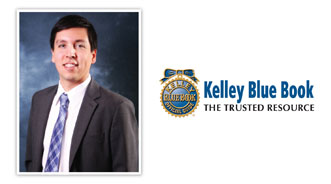KBB Explains Why March 2013 Is Crucial to Off-Lease Volume

Dealers looking for off-lease units might want to mark March 2013 on their calendars. That’s when Kelley Blue Book thinks wholesale volumes for these valuable used units might finally edge higher.
The reason KBB believes it will be about 18 months before off-lease availability increases is that’s when a larger amount of leased units begin to return to auction.
“In the meantime, dealers should expect to continue to pay a premium at auction as lease returns remain few and far between,” acknowledged Alec Gutierrez, KBB’s manager of vehicle valuation, in the October edition of the Blue Book Market Report.
Whether dealers are looking for off-lease units or any kind of decent used vehicle to fill inventory, it’s getting more heated in the lanes and online wholesale channels.
“Where there used to be friends amongst each other in the lanes where a particular unit comes in that works well, you would flip a quarter for it. You have this one. I’ll get another one. That’s gone,” shared Brian Berkanpas, who owns Big Deal Auto, a buy-here, pay-here dealership in Sioux City, Iowa, that caters to customers in three states.
“There are no friends at the auto auction anymore. It’s a battle every single day,” Berkanpas added.
KBB reiterated why it’s been so hard for Berkanpas and other independent stores as well as franchised dealerships to find quality used vehicles.
“Used-vehicle supply at auction has taken a hit due to the drop in new-vehicle sales from 16 million units in 2007 to 10.5 million units in 2009,” Gutierrez explained. “This steep decline in sales has led to a lack of trade-ins, fleet sales and lease returns that would typically replenish used-car supply at auction throughout the year.
“While already a problem for dealers, this supply shortage will likely be most pronounced for the next six to 12 months, due to a substantial reduction in leasing from August 2008 through March 2010,” he continued.
“As new-vehicle sales slipped, leasing took an especially hard hit as banks tightened up lending standards and reduced lease offers due to the uncertainty surrounding the future of both the auto industry and economy as a whole,” Gutierrez went on to say.
KBB insisted lease-return volume at auction has been limited for at least the past 12 months, approximately two years out from the initial decline in lease originations.
“Since the majority of leases cover between 24- to 36-month terms, we expect lease return volume to remain lowest through March of 2012 — 24 months after leasing started to rebound,” Gutierrez surmised.
And what will that activity do to wholesale prices?
“Although we expect values to continue to decline in the short term, a low supply of used late-model vehicles will continue to limit used-vehicle depreciation for the next several years,” Gutierrez conceded.
Seasonal Declines and Fuel Price Corrections Continue
KBB determined used-vehicle values dropped 2.3 percent in September, bringing the total market decline to 6.6 percent since its June peak.
Gutierrez pointed out compact cars have been hit especially hard since increasing 20 percent earlier this year in response to rising fuel prices and the earthquake in Japan. Since June, he mentioned values have declined 9 percent for fuel-efficient compact cars with the most pronounced drops coming from hybrid vehicles such as the Toyota Prius, which has declined in excess of $4,000.
“The fourth quarter will bring much of the same as values for compact cars continue to correct and a seasonal fourth quarter lull at auction sets in, Gutierrez explained. “Values are typically soft during the fourth quarter as dealer activity at auction tends to slow down during the holiday season.”
While the market is expected to continue to decline, KBB expects the drops to be relatively mild overall, likely between 1 to 2 percent per month through the fourth quarter.
“While overall declines should be mild, we expect compact cars to continue to correct by as much as 6 to 8 percent through year-end,” Gutierrez added.
KBB Examines Market Share Volatility with Japanese Losing Ground Due to Supply
KBB noted September inventory figures for Japanese brands improved slightly over August, giving the first indication that the “worst may be over.”
Gutierrez thinks an increase of nearly 15,000 units provides a signal that in the coming months more inventory should become available.
“Additional product cannot arrive soon enough for dealers in the U.S. as they continue to give up share in their most important high-volume segments,” he stressed.
Overall, KBB determined Japanese market share has declined 4 points since 2010, dropping from 38.6 percent in 2010 to 34.8 percent through August of this year. Analysts calculated this 4-point drop equates to a loss of more than 300,000 potential sales that were diverted primarily to the domestic and Korean manufacturers.
Although overall Japanese share is down 4 points, KBB believes there are more pronounced declines in a handful of crucial segments.
Analysts discovered share in the ultra-competitive compact car, mid-size car and compact crossover segments is down significantly for the Japanese due to their inability to meet high demand as well as improved offerings from the competition.
“Additional inventory is crucial in these segments, especially for highly anticipated redesigns such as the 2012 Toyota Camry, 2012 RAV4, 2012 Honda Civic and 2012 Honda CR-V,” Gutierrez explained.
“Among all Japanese brands, Toyota and Honda have taken the most significant hit in terms of overall market share,” he continued. Toyota and Honda suffered most from the earthquake, shedding 2.5 points and 1.5 points, respectively, allowing Hyundai, Chrysler and GM to each benefit by 1 point or more.
“While a gain or loss of a few points may seem insignificant, when we examine the impact to volume and potentially lost revenue, we begin to see the importance of market share,” Gutierrez went on to say.
Explanation of Connection Between Revenue and Volume
Before going into his analysis of revenue and volume, Gutierrez reflected back on the natural disaster that shook Japanese automakers so significantly.
“The overall loss of share by Japanese manufacturers cannot be taken lightly,” he cautioned. “The earthquake and ensuing tsunami that devastated Japan on March 11 of this year will likely impact these manufacturers for years to come.
“Already, the financial toll has been tremendous,” Gutierrez emphasized. “In fact, we determined that Toyota and Honda have lost in excess of 350,000 potential sales combined so far this year by applying their 2010 market share by segment to 2011 sales volume actuals.
“This loss of potential sales has resulted from the inability of Honda and Toyota to produce and import the vehicles highly demanded by consumers today,” he added.
KBB computed the volume lost by Toyota and Honda equates to an approximate revenue shortfall of $5 billion and $3.2 billion, respectively. The firm said the revenue approximation is calculated by multiplying invoice pricing less dealer holdback and regional marketing funds to the approximate sales volume lost due to the earthquake.
“While the Japanese have taken a substantial hit to both sales volume and gross revenue, GM, Chrysler and Hyundai have pulled ahead as the most significant beneficiaries to Honda and Toyota’s missed opportunities,” Gutierrez surmised.
KBB thinks General Motors has proven to be the primary beneficiary of Japan’s lost market share by increasing share and subsequently sales by more than 130,000 units versus 2010. Analysts contend this rise equates to an approximate increase in gross revenue of nearly $3 billion through August.
KBB pointed out Hyundai is not far behind, having picked up close to 120,000 sales and $2.5 billion in gross revenue.
“Incredibly, Hyundai has been able to increase share while combating inventory shortages of its own,” Gutierrez asserted.
“While not severely impacted by the earthquake, Hyundai is in the enviable position of demand outstripping supply due to the highly acclaimed redesigns they have churned out during the past two years,” he continued.
“The all-new Elantra, Sonata, Optima, Sportage, Genesis and Tucson are but a few of the top-notch redesigns greatly benefitting the brand in today’s competitive environment,” Gutierrez added.
Although domestic and Korean manufacturers have found success capturing market share, KBB stressed that the industry can’t rule out the Japanese OEMs just yet.
“Japanese production should be hitting full steam right about now and we are likely to see an influx of Japanese vehicles hitting our shores in the coming months,” Gutierrez noted.
“As new product arrives, we expect Toyota and Honda to increase cash incentives relative to their current levels, but generally not to exceed $1,000,” he projected.
“In addition to cash incentives, there are many attractive lease deals available today in the marketplace that we expect to remain through the rest of the year.” Gutierrez said.
KBB acknowledged that for the Japanese automakers to boost its sales and revenue performance, it won’t be as simple as upping incentives.
“The competitive landscape is like nothing the Japanese have dealt with in recent memory. Nearly all manufacturers are producing top-quality vehicles in every segment,” Gutierrez emphasized.
“Even the historically Japanese-dominated compact segment has seen excellent product arrive in the form of the well-received Chevrolet Cruze, Ford Focus and Hyundai Elantra,” he continued.
“The Japanese may be down, but they are certainly not out,” Gutierrez went on to say. “With several redesigns hitting our shores this year, it may only be a matter of time before the Japanese begin to recapture some of their lost share.”
What Economic Woes Could Do to 2011 SAAR
With only one quarter to go in 2011, KBB indicated most economic indicators suggest that the economy is still years away from hitting a level that will support new-vehicle sales resembling anything close to the days of 16 million SAAR.
“Unemployment, housing, consumer confidence and GDP are only but a few of the economic indicators currently pointing to a sustained lull rather than a robust recovery,” Gutierrez explained.
“If we look back to 2005, when 16.5 million vehicles were sold, we can see the economy was on seemingly much stronger footing,” he continued. “Of course, we now know in retrospect that the strength in the U.S. economy in 2005 was predicated on an unsustainable housing boom fueling growth and confidence that was later discovered to be unsustainable.”
KBB pointed out the latest federal open market committee statement released by the Federal Reserve on Sept. 21 highlights even the Fed’s recognition of a likely prolonged economic slump.
“According to the statement, while the Fed expects ‘some pickup in the pace of recovery over coming quarters,’ they also highlight the presence of ‘significant downside risks … including strains in global financial markets,’” Gutierrez recapped.
“The Fed also pointed to continuing weakness in overall labor market conditions, giving a sense that while they expect growth, it may not be very robust growth,” he also mentioned.
To combat the economic downturn, KBB noted the Fed has kept interest rates at historic lows and pledged to maintain rates at their current levels through at least 2013.
“Even with rates at historic lows, banks remain reluctant to lend and the economy has yet to improve significantly,” Gutierrez conceded.
“With the current economic outlook shaky at best, there is very little indication that the economy will return to 2005 level performance for several years to come,” he cautioned.
However, KBB stressed all the news isn’t bad.
Although many leading indicators are relatively negative, analysts noted a few have at least shown signs of modest improvement or at worst, stability.
“With this in mind, we expect very modest improvements in vehicle sales over the next several years,” Gutierrez said.
“We still believe 12.5 million vehicles will be sold in 2011 and given the current state of the economy and the expectation for very little growth moving forward, we do not expect to see sales significantly in excess of 13 million,” he concluded.

 View The Latest Edition
View The Latest Edition

